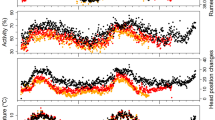Abstract
The locomotory activity of adult Penaeus indicus Milne Edwards and P. monodon (Fabricius) collected from the Vellar estuary, South India, in 1983 was monitored continuously for a period of 40 d in the laboratory. Both species exhibited persistent circatidal and circadian rhythmicity, the former displayed peak activity during predicated times of high water in their original habitat. The latter exhibited peak activity during periods corresponding to in situ night-time, with almost no activity during the day, except at the time of high tide. The tidal and daily rhythms were evident for only 3 to 4 d and 5 to 6 d, respectively, under laboratory conditions. The amplitude of the rhythms displayed variations in each semilunar period, reflecting the synchrony and dissynchrony of the tidal and daily rhythms. Activity was correlated with phases of the moon, peaking at times of new and full moon, and showing a scattered pattern with smaller peaks during the first and third quarters.
Similar content being viewed by others
Literature cited
Aschoff, J. (1965). Circadian clocks. North Holland, Amsterdam
Bünning, E. (1973). The physiological clock. 3rd ed. English Universities Press, London
Chandrashekaran, M. K. (1965). Persistent tidal and diurnal rhythm of locomotor activity and oxygen consumption in Emerita asiatica. Z. vergl. Physiol. 50: 137–150
Chovnick, A. (1960). Biological clocks. Waverley, Baltimore, Maryland
Cloudsley-Thompson, J. L. (1961). Rhythmic activity in animal physiology and behavior. Academic Press, New York
Dall, W. (1958). Observations on the biology of the green tail prawn Metapenaeus mastersii (Haswell) (Crustacea, Decapoda, Penaeidae). Aust. J. mar. Freshwat. Res. 9: 111–134
DeCoursey, P. J. (1983). Biological timings. In: Bliss, D. E. (ed.) The biology of crustacea. Vol. 7. Academic Press, New York, p. 107–162
Eldered, B., Engle, R. M., Woodburn, K. D., Hutton, R. F., Jones, H. (1961). Biological observations on the commercial shrimp Penaeus duorarum Burkenroad in Florida waters. Fla. St. B Conserv. Mar. Lab., Prof. Pap. Ser. 3: 1–139
Enright, J. T. (1963), The tidal rhythm of activity of a sand beach amphipod. Z. vergl. Physiol. 46: 276–313
Enright, J. T. (1972). A virtuous isopod: circalunar rhythms and their tidal fine structures: J. comp. Physiol. 77: 141–162
Fincham, A. A. (1973). Rhythmic swimming behaviour of the New Zealand sand beach isopod Pseudaega punctata Thomson. J. exp. mar. Biol. Ecol. 11: 219–237
Fincham, A. A. (1974). Rhythmic swimming of the isopod Exosphaeroma obtusum (Dana). New Zealand J. mar. Freshwat. Res. 8: 655–662
Fuss, C. M. (1964). Observations on burrowing behaviour of the shrimp Penaeus duorarum Burkenroad. Bull. mar. Sci. Gulf and Carib. 14: 62–73
Fuss, C. M., Ogren, L. H. (1966). Factors affecting activity and burrowing habits of the pink shrimp Penaeus duorarum. Biol. Bull. mar. biol. Lab., Woods Hole 130: 170–191
Harker, J. E. (1964). The physiology of diurnal rhythms. Cambridge University Press, London
Hindley, J. P. R. (1975). Effects of endogenous and exogenous factors on the activity of the juvenile banana prawn Penaeus merguiensis. Mar. Biol. 29: 1–8
Hughes, D. A. (1968). Factors controlling emergence of pink shrimp Penaeus duorarum from the substrates. Biol. Bull. mar. biol. Lab., Woods Hole 134: 48–59
Hughes, D. A. (1969a). Responses to salinity changes as a tidal transport mechanism of pink shrimp Penaeus duorarum. Biol. Bull. mar. biol. Lab., Woods Hole 136: 45–53
Hughes, D. A. (1969b). Evidence for the endogenous control of swimming in pink shrimp Penaeus duorarum. Biol. Bull. mar. biol. Lab., Woods Hole 136: 398–404
Jones, D. A., Naylor, E. (1970). The swimming rhythm of the sand beach isopod Eurydice pulchra. J. exp. mar. Biol. Ecol. 4: 188–199
Moller, T. H., Jones, D. A. (1975). Locomotory rhythm and burrowing habits of Penaeus semisulcatus and Penaeus monodon. J. exp. mar. Biol. Ecol. 18: 61–77
Morgan, E. (1965). The activity rhythm of the amphipod Corophium volutator (Pallas) and its possible relationships to changes in hydrostatic pressure associated with the tides. J. Anim. Ecol. 34: 731–746
Naylor, E. (1958) Tidal and diurnal rhythm of locomotor activity in Carcinus maenas. J. exp. Biol. 35: 602–610
Palmer, J. D. (1974). Biological clocks in marine orgainisms. Willey (Interscience), New York
Pittendrigh, C. S., Dann, S. (1976). A functional analysis of circadian pacemaker. I. The stability and spontaneous frequency in nocturnal rodents. J. comp. Physiol. 106: 223–252
Subbaraj, R., Chandrashekaran, M. K. (1981). Mirror imaging phase response curves obtained for the circadian rhythm of a bat with single steps of light and darkness. J. interdiscip. Cycle Res. 12: 305–312
Subramanyam, C. B. (1976). Tidal and diurnal rhythm of locomotor activity and oxygen consumption in the pink shrimp Penaeus duorarum. Contr. mar. sci. Univ. Tex. 20: 123–132
Tide table Part I, (1983). Prepared and published by the geodetic and research branch, India
Wickam, D. A. (1967). Observations on the activity patterns in juveniles of the pink shrimp Penaeus duorarum. Bull. mar. Sci. 17: 769–789
Author information
Authors and Affiliations
Additional information
Communicated by O. Kinne, Oldendorf/Luhe
Rights and permissions
About this article
Cite this article
Natarajan, P. Persistent locomotor rhythmicity in the prawns Penaeus indicus and P. monodon . Marine Biology 101, 339–346 (1989). https://doi.org/10.1007/BF00428130
Accepted:
Issue Date:
DOI: https://doi.org/10.1007/BF00428130




